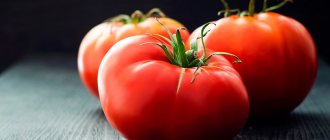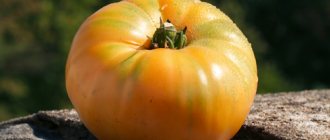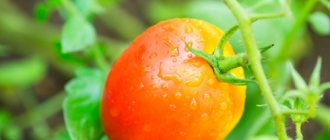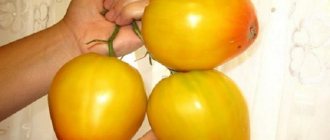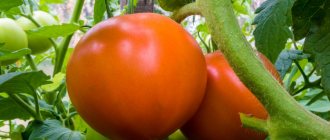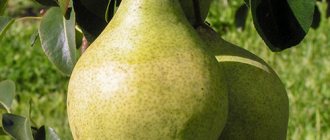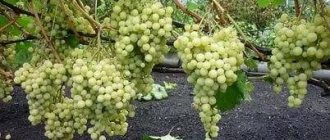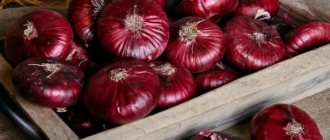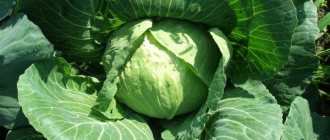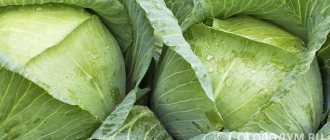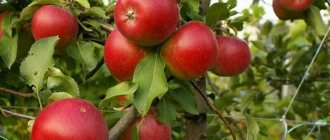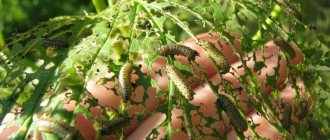All farmers want beautiful, unpretentious, tasty tomatoes. Then you can plant Lorraine beauty. The colorful fruits are shaped like a dahlia or a tropical flower. For its elegance and excellent taste, the variety has repeatedly received top awards at competitions and exhibitions.
| Height | Landing location | Ripening time | Fruit color | Fruit size | Origin | Fruit shape |
| Tall | Greenhouse, Open ground | Mid-season | Reds | Large | Variety | Flat-round |
Tomatoes Lorraine Beauty: variety description
| Variety name | Lorraine beauty |
| general description | Mid-ripening and late-ripening indeterminate variety |
| Originator | USA |
| Ripening period | 110-120 days |
| Form | Flat-rounded |
| Color | Red |
| Average weight of tomatoes | up to 500 grams |
| Application | Fresh |
| Productivity of the variety | 5-7 kg per bush |
| Features of cultivation | Standard agricultural technology |
| Disease resistance | Resistant to viruses |
The Lorraine beauty tomato is a rare variety, popular among fans of unusual fruits. The bush is indeterminate, reaches a height of 1.5 m, some specimens grow up to 2 m. Not standard.
The variety is mid-season; in open ground it behaves like a late-season variety.
The yield is average, 10-15 tomatoes are produced per bush. Fruiting begins in July and continues until September.
The fruits are flat-rounded, large, weighing up to 500 g. The shape is ribbed, corrugated, and in cross section the tomato resembles a flower. The color is ruby red, rich. The taste is pleasant, sweetish. A large number of empty internal chambers gives the fruits a beautiful appearance, but makes them less juicy.
The taste of the fruit depends on the growing conditions; in hot weather, tomatoes turn out sweeter. They store well; tomatoes collected at the stage of technical ripeness ripen successfully at home.
The weight of the fruits of the variety can be compared with others in the table:
| Variety name | Fruit weight |
| Lorraine Beauty | up to 500 grams |
| Big Mama | 200-400 grams |
| Banana Orange | 100g |
| Honey saved | 200-600 grams |
| Rosemary pound | 400-500 grams |
| Persimmon | 350-400 grams |
| Dimensionless | up to 100 grams |
| f1 favorite | 115-140 grams |
| Pink flamingo | 150-450 grams |
| Black Moor | 50 grams |
| Early love | 85-95 grams |
History of growing tomato Lorraine beauty
The Beauty Lottringa tomato is of North American origin and has been known for quite some time. In its homeland, the variety has no industrial significance and was bred specifically for decorative purposes, but its fruits are not only edible, but also have a completely satisfactory taste. Amateur gardeners and farmers grow it quite rarely: rather, it is of interest to people who like to work with rare and not very common crops and varieties.
The Lorraine beauty is distinguished by the shape of its fruit, which in cross-section is similar to a flower. In the State Register of Breeding Achievements of the Russian Federation, in the “Tomatoes” section, there is no section on varieties for decorative purposes, and Lorraine Beauty is not registered in the document. But our lovers often plant several bushes on their plots; the fruits of this variety are a success at various vegetable growing exhibitions.
Origin and purpose
The variety was bred in the USA and is intended for cultivation in open ground or in greenhouses. In heated greenhouses, fruiting begins in July; in open ground, the first fruits appear in August. The variety prefers high temperatures and moderate humidity.
Lorraine Beauty tomatoes are most often used fresh. Their spectacular cut appearance makes them indispensable for assorted vegetables, side dishes, and buffets. Stuffing is possible. Not suitable for canning.
Varieties
One of the most unique varieties of the Lorraine beauty tomato is the yellow hybrid. The fruits are corrugated, ribbed, bright yellow in color, and look very beautiful when sliced. They are often used to decorate holiday tables.
The plant is indeterminate, of medium maturity.
Description of the bush
Tomato bushes usually reach a size of 1.5 to 2 m, not standard, indeterminate.
Description of fruits
The fruits have an original shape: round-flat, ribbed corrugated, rich red color. Tomatoes have a sweet taste.
According to the description of the Lorraine Beauty tomato variety, its fruits are large, the weight of one can reach 500 g. The fruits are not juicy due to crypts - empty chambers. They contain few seeds, the skin rarely cracks, the flesh is dense and sweet.
The fruits are used only fresh; they are not suitable for canning.
Application
The harvest of this variety is suitable for fresh consumption - the vegetables are used to decorate various dishes, and delicious salads and assorted vegetables are prepared from them. Tomatoes are suitable for stuffing, but are not used in canning.
Lorraine beauty: a tomato that will surprise neighbors and family
Tomato varieties are conventionally divided into salad, canned and universal. In addition, there are a small number of varieties that can be called “decorative gift”: their fruits most often do not have a memorable taste, but have an interesting unusual shape or coloring. One of these varieties is the Lorraine beauty tomato.
Origin and purpose
The variety was bred in the USA and is intended for cultivation in open ground or in greenhouses. In heated greenhouses, fruiting begins in July; in open ground, the first fruits appear in August. The variety prefers high temperatures and moderate humidity.
Lorraine Beauty tomatoes are most often used fresh. Their spectacular cut appearance makes them indispensable for assorted vegetables, side dishes, and buffets. Stuffing is possible. Not suitable for canning.
Description of the tomato Lorraine beauty yellow
The Lorraine beauty yellow tomato is very decorative, similar to a dahlia. The degree of ribbing, setting, and the presence of “shoulders” on the stalk depend on the temperature conditions of fruit formation. The ribbing gives the fruit a brighter yellow color, a delicate taste, the ability to beautifully cut the fruit, fleshy, with a typical tomato smell, weighing 350-500 or more. Use in salads, juices, sauces, suitable for storage.
Lorraine beauty yellow
In addition to red, there is also a yellow variety with ribbed, corrugated fruits. In terms of general characteristics, these two tomatoes are similar - both are indeterminate in the average ripening period. The color of the tomato is bright yellow-orange. The cutting looks very beautiful together with red ones, very similar to flowers.
Agricultural technology of tomato Lorraine beauty yellow
Sowing seedlings 50-70 days before planting in a permanent place. The temperature for quick and friendly seed germination is 20-25°C; after the first shoots appear, for the growth of a powerful root system (this is especially important for greenhouses), set the temperature for the seedlings to 12-15°C for 2-3 days with round-the-clock supplementary lighting. Planting in the ground at night temperatures of 14-16°C, and the soil at a depth of 10-12 cm is not lower than 12°C, pour water into the hole until it is hardly absorbed, plant without damaging the earthen ball, the top layer of soil should be dry. Suitable for all types of greenhouses and open ground. The description is given when the bush develops within the range of 15-26°C. Prolonged temperatures, higher and lower, change the characteristics of the variety. The normal height in open ground is 150 cm, in protected ground - 180 cm. The beginning of ripening in a greenhouse is 110 days from germination, in open ground - 120 days. Tip: stop watering 2 weeks before ripening.
Characteristics of the variety
Tomato Lorraine beauty is an indeterminate tall variety. The bushes are spreading and bushy. Shoots grow up to 1.7-2 m. The foliage is moderate. The bushes bear 8-12 fruits, a total of 5-6 fruiting clusters with 2-3 tomatoes on each.
Characteristics and description of tomatoes:
- average weight 400-500 g;
- the shape is round and slightly flattened;
- pronounced ribbing, the sides are corrugated like an accordion;
- the color is bright ruby, orange or yellow depending on the variety;
- pulp with chambers, moderately juicy;
- The taste is sweet with a delicate hint of sourness.
The spectacular cross-section with chambers resembles a flower. Tomato is used to decorate vegetable and meat dishes.
Fruiting may be delayed, and the variety is considered late.
Designed for planting:
- to open beds in the southern regions;
- in greenhouse conditions in the north and in the temperate zone.
More often used for personal gardens and garden plots, less often on an industrial scale.
Tomatoes are a decoration for the festive table and are indispensable for buffets and celebrations.
Productivity
The characteristics of the variety include average yield: about 10-12 tomatoes (3-4 kg per bush) can be harvested from one plant. In wet and rainy summer conditions, the indicators are very low - 3-4 tomatoes per plant.
Advantages and disadvantages
Feedback from gardeners about the experience of growing and the taste of Lorraine Beauty tomatoes allows us to add some advantages and disadvantages to the description of the variety. Characteristic positive qualities are called:
- original, decorative appearance of the fruit;
- good, moderately sweet taste;
- resistance to many diseases;
- preservation of commercial qualities during long-term storage;
- good yield indicators.
But gardeners also note the disadvantages of this tomato:
- hollowness and dryness of fruits;
- unsuitable for further processing and preservation;
- great heat tolerance for growing in our climate.
Characteristics of the Lorraine beauty tomato
Tomatoes Lorraine beauty are an indeterminate variety, not standard, tall. The bush reaches 1.5 m in height. The shoots are straight, thin, green without pubescence. The foliage is weak. The leaf blade is green or light green, elongated, with cut edges, pointed at the tip.
The plant has a medium-late ripening period: the fruits are harvested 110-120 days after the appearance of the first shoots.
The tomato is large, the average weight is 450-500 g. The shape is ribbed, corrugated, and in cross section resembles a flower. The surface is bright red, dense. Inside contains dryish pulp with a pleasant sweet taste. The internal chambers have voids, so the juiciness of the fruit is average.
Fruit characteristics
The Lorraine beauty tomato is an elegant large, ribbed, rounded fruit, flattened at the top. Outwardly they look like a closed flower with wide petals. The color of ripe tomatoes is bright scarlet. Weight is 200-350 grams, with proper agricultural technology it can reach half a kilogram.
The inside is multi-chambered, hollow, almost without seeds. The taste is sweetish with sourness. Suitable only for fresh consumption - slicing or stuffing looks impressive on the table. Dense, resistant to cracking. They are stored for a long time. They ripen well when picked brown.
Properties of the variety
The tomato is of American origin, more precisely of US selection. Tomatoes are of indeterminate type, with a height of 1.5 to 2 meters. The average late ripening period is 110-120 days. It is grown both in greenhouses and open ground. Self-pollinating. Productivity is low - no more than 3-4 kg per bush. Under unfavorable weather conditions, you can generally get 2-3 tomatoes.
The characteristics of resistance to viral and fungal diseases are as follows: resistant to Fusarium wilt, gray leaf spot, tobacco mosaic, Alternaria stem cancer, verticillium, cladosporiosis, nematode. Not resistant to root and white rot.
The bush is not standard - the stems are thin in constitution, large, slightly corrugated leaves. You can also add to the description of the variety that due to its specificity, it is not grown in agriculture on an industrial scale. This is a tomato for amateur gardeners and collectors of unusual plants.
Productivity
From 1 m2 they collect 6-9 kg. Hence the conclusion is that the yield is high.
Features of cultivation
Tomatoes of the Lorraine Beauty variety are no different in cultivation technology from most classic varieties:
- sowing seeds - obtaining seedlings.
- picking.
- transplanting.
- cultivation - watering, fertilizing, garter formation.
- harvesting.
Sowing seeds for seedlings for open ground, taking into account the climate zone, is carried out no earlier than two months before the onset of stable warm weather. After 3-4 weeks, in the phase of 2-3 true leaves, they peak. They are planted approximately 30 days after picking. If warm weather has not yet established itself, the seedlings should be “tempered” - treated with the drug “Tur” or another growth regulator to avoid overgrowth.
The planting pattern is 60 x 50. The interval along the rows is 60 cm, between plants 45-50. Due to its resistance to cracking, the beauty does not require strict adherence to the watering regime, but the soil should not be allowed to dry out too much.
The formation of the bush is carried out by removing the stepsons and gartering. It is produced in one trunk, however, according to reviews from gardeners, there is successful experience in growing tomatoes in two trunks.
Selection of fertilizers according to the classic P-NK scheme. During the development period, the complex contains a large percentage of nitrogen, during flowering and ovary - phosphorus, and when fruits ripen, potassium is needed. To prevent blossom end rot, periodically give Ca, that is, calcium nitrate. Fruiting continues as long as weather conditions permit. With the onset of cold weather, the still green fruits will grow well at room temperature.
Advantages and disadvantages
The main advantages of the Lorraine Beauty variety:
- very impressive appearance of the fruit;
- pleasant sweetish taste;
- It is convenient to tie up bushes that are not too tall;
- good yield;
- resistance to viral diseases.
The yield indicators of different varieties can be found in the table:
| Variety name | Productivity |
| Lorraine Beauty | 5-7 kg per bush |
| Bobcat | 4-6 kg per bush |
| Apples in the snow | 2.5 kg per bush |
| Russian size | 7-8 kg per square meter |
| Yablonka Russia | 3-5 kg per bush |
| King of Kings | 5 kg per bush |
| Kate | 15 kg per square meter |
| Long Keeper | 4-6 kg per bush |
| Raspberry ringing | 18 kg per square meter |
| Grandma's gift | 6 kg per square meter |
| Crystal | 9.5-12 kg per square meter |
Among the shortcomings are noted:
- insufficient juiciness, “hollowness”;
- in open ground in cool weather the yield is significantly reduced;
- at insufficient temperatures, not all ovaries have time to develop into fruits.
Advantages and disadvantages compared to other similar varieties
The Lorraine beauty tomato is grown infrequently, but is well described in the literature, and there are reviews about it from amateur gardeners. At the same time, both the advantages of the variety and its disadvantages are noted. The advantages include:
- original unusual appearance of tomatoes;
- long-term preservation and transportability of fruits;
- the ability of tomatoes to ripen during storage;
- good, for an ornamental variety, sweetish taste;
- resistance to a number of diseases.
The list of disadvantages includes:
- hollowness of fruits;
- presence of dryness in taste;
- unsuitability of fruits for processing;
- significant dependence of yield on weather.
So, in the central zone of our country, the Lorraine beauty can still be grown in unprotected soil, but a little further north it can bear fruit normally only in greenhouses.
There are very few varieties intended specifically for decoration, but there are tomatoes with a similar, strongly ribbed fruit shape. Thus, the new domestic variety Garmoshka is considered a salad variety and is characterized by excellent taste and high yield. The fruits are pink, pear-shaped, strongly ribbed, very large. The Mushroom Basket tomato has good taste; the yield of strongly ribbed, flat-round pink fruits is at the same level as that of the Lorraine beauty. The very large ribbed fruits of the Cheerful Neighbor tomato, which appeared only a few years ago, have good taste and high yield.
Advantages and disadvantages
The main advantages of the Lorraine Beauty variety:
- very impressive appearance of the fruit;
- pleasant sweetish taste;
- It is convenient to tie up bushes that are not too tall;
- good yield;
- resistance to viral diseases.
The yield indicators of different varieties can be found in the table:
| Variety name | Productivity |
| Lorraine Beauty | 5-7 kg per bush |
| Bobcat | 4-6 kg per bush |
| Apples in the snow | 2.5 kg per bush |
| Russian size | 7-8 kg per square meter |
| Yablonka Russia | 3-5 kg per bush |
| King of Kings | 5 kg per bush |
| Kate | 15 kg per square meter |
| Long Keeper | 4-6 kg per bush |
| Raspberry ringing | 18 kg per square meter |
| Grandma's gift | 6 kg per square meter |
| Crystal | 9.5-12 kg per square meter |
Among the shortcomings are noted:
- insufficient juiciness, “hollowness”;
- in open ground in cool weather the yield is significantly reduced;
- at insufficient temperatures, not all ovaries have time to develop into fruits.
Features of growing seedlings
Tomatoes of the Lorraine Beauty variety are no different in cultivation technology from most classic varieties:
- sowing seeds - obtaining seedlings.
- picking.
- transplanting.
- cultivation - watering, fertilizing, garter formation.
- harvesting.
Sowing seeds for seedlings for open ground, taking into account the climate zone, is carried out no earlier than two months before the onset of stable warm weather. After 3-4 weeks, in the phase of 2-3 true leaves, they peak. They are planted approximately 30 days after picking. If warm weather has not yet established itself, the seedlings should be “tempered” - treated with the drug “Tur” or another growth regulator to avoid overgrowth.
Useful video
Watch the video: American varieties of tomatoes
| Late ripening | Early ripening | Mid-late |
| Bobcat | Black bunch | Golden Raspberry Miracle |
| Russian size | Sweet bunch | Abakan pink |
| King of Kings | Kostroma | French grape |
| Long Keeper | Brawler | Yellow banana |
| Grandma's gift | Red bunch | Titanium |
| Podsinsky miracle | The president | Slot |
| American ribbed | Summer resident | Krasnobay |
If you find an error, please select a piece of text and press Ctrl+Enter.
Transfer rules
With proper care you can get a rich harvest
In order for the sprouts to successfully take root in a new place, they should be hardened off. A week before transplanting, the seedlings are taken out into the fresh air, increasing the time spent outside daily.
Preparing the bed
Replanting is carried out in the middle or at the end of May, when the soil warms up to a temperature of 10-12°C.
The bed is cleared of the remains of last year's vegetation, sprinkled with humus (10 kg), wood ash (3 kg) and mineral preparations - 100 g of potassium salt and superphosphate. This amount is calculated for a plot of 1 m².
Technology of transplanting seedlings into the ground
This is a tall variety, so it requires a lot of space on the site - the optimal planting scheme is 50x60 cm. 4-5 bushes are planted per 1 m².
They dig holes, spill them with warm water, then lower the roots of the plants, cover them with soil without fertilizers and hill them up. Next to each bush, stakes are driven in, which will serve as further support.
After planting, the tomatoes are shaded to eliminate the risk of burning young foliage and stems. It is advisable to cover it with film at night, as the bushes may freeze.
Planting and care
Watering tomatoes should be done once a week. If you water frequently, the bushes may wither and the roots will rot, which can lead to the death of the plants. When watering, you can add feeding solutions.
The Lorraine beauty tomato variety will give a good harvest, provided all the rules of care and maintenance are followed.
- Watering. The first moistening is carried out a week after transplanting the tomatoes into the garden bed. 1 liter of water is poured under each bush. The following procedure is carried out only after the top layer of soil has dried. The bushes experience the greatest need for moisture during the phase of budding and fruit filling, so the frequency of watering is increased to 2 times a week.
- After watering, the soil is loosened, the rows are weeded and weeds are removed. To eliminate the risk of the roots drying out, the bushes are mulched with garden soil a day after moistening.
- Tomato is responsive to organic and mineral fertilizers. The first feeding is carried out 7-10 days after transplanting the seedlings - add a solution of nitrophoska or urea - 1 tbsp. l. on a bucket of water. 200 ml of solution is poured under each bush. At the budding stage, tomatoes are spilled with liquid mineral fertilizer - 15 g of superphosphate and potassium salt per 10 liters of water. Consumption - 0.5 l per bush. The same composition is used to water the plants during the fruit-filling phase. Additionally, foliar nutrition of the bushes is carried out - irrigated with a solution of boric acid (0.2 g per liter of hot water 60°C). Plants can also be sprayed with iodine solution, which increases immunity against diseases and improves the quality of flowering and fruiting: 5 drops diluted with 3 liters of water. Foliar nutrition is carried out before flowering and a week after it.
- Forming a bush into two stems. The essence of the procedure is to isolate the central stem and the first stepson, which is formed under the first flower brush. All other stepsons 5-7 cm long must be removed. To avoid injury to the main stem, stepchildren must be removed with sterile scissors or a blade. The cut areas should be powdered with charcoal to avoid infection.
- As the main stem grows, it must be tied regularly to avoid the risk of breaking off under the weight of the fruit.
Tomato care Lorraine beauty
The agricultural technology for growing the tomato variety Lorraine Beauty is practically no different from cultivating other varieties. Tomatoes also need timely watering, plenty of sun and heat. Also, do not forget about regular fertilizing and tillage of the soil and bushes.
Watering
As already mentioned, Lorraine Beauty tomatoes do not tolerate cold. Therefore, you need to water the bushes only with warm water. Cold tap water will instantly cause plant stress: they will stop growing and begin to bear fruit poorly.
Fact: the optimal soil moisture for proper plant growth is 85-90%.
It is worth watering tomatoes rarely, but abundantly. In a greenhouse, it is enough to wet the soil once every 3-4 days. This is quite enough, since water evaporates slowly in the greenhouse. In hot weather, the amount of watering can be increased, but then the ventilation in the greenhouse should be increased to lower the air temperature and slightly reduce air humidity.
To get a good harvest, you need to use high-quality seeds. The most productive varieties are possible. Large selection of varieties for every taste.
Up to three liters of water should be poured under each tall bush at a time. It is necessary to pour water only at the root, trying not to touch the leaves and stem. The drier the leaves are, the less harmful bacteria will form on them, leading to fungal diseases.
Pests and diseases: prevention and treatment
The tomato variety Lorraine Beauty is quite resistant to viruses (mosaic, fusarium wilt).
However, bushes can be affected by gray, white or root rot. Preliminary watering of the soil with a solution of potassium permanganate or copper sulfate, constant loosening and mulching of the rows with peat or straw helps in the fight.
Tomatoes attract pests that spoil leaves and roots: aphids, whiteflies, thrips. In open ground, plants can be attacked by slugs, cutworms and Colorado potato beetles.
For prevention, you can plant herbs next to the tomatoes, for example, leaf mustard or parsley. Spraying with an aqueous solution of ammonia helps destroy pests. Insecticides should not be used after flowering has begun.
Lorraine Beauty tomatoes are a rare and unusual variety that is worth trying to grow on your own plot
It is not too demanding on living conditions; it is important to monitor watering and temperature, as well as protect plants from pests
One or two bushes in a greenhouse are enough to surprise your home with elegant chrysanthemum tomatoes for several months.
The Lorraine beauty tomato variety is interesting in the shape of its fruit, which is used to decorate salads. However, there are a number of domestically produced varieties that are in no way inferior in quality and bear fruit no less beautiful tomatoes.
Sowing, diving and planting in the ground
- The yar is carried out into the moist soil into the grooves made. The top of the caterpillar is covered with film or glass. If it is necessary to organize additional lighting for faster germination, special lamps are used.
- The air temperature should be approximately 25 degrees.
- After emergence of seedlings, the shelter can be removed.
- When 2-4 leaves are formed, the seedlings should be planted in separate pots, or cups.
- Before planting in the ground, plants must be hardened off. In this case, the seedlings are taken outside every day for a week. This is necessary so that they get used to the change in habitat and conditions) to adapt to the open air.
- Ready seedlings are planted in the ground or in a greenhouse at the end of May. The distance between plants should be at least 50 cm.
- A nutrient mixture of organic fertilizers should be added to the prepared holes. A ridge is installed next to the holes, where the bushes will be tied as they grow. To obtain larger fruits, the lower branches should be plucked. Ant. start off.
3 bushes are placed per 1 m2. The distance between the holes is 50-60 cm, the depth of the holes is 30 cm.
